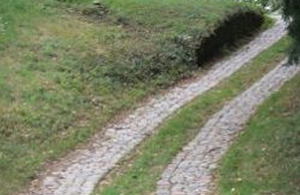DFID Research: Better roads for Africa
The Global Transport Knowledge Partnership is helping inform people about new ways to build sustainable road transport in Africa.

Hand-packed cobbles can make effective surfaces for roads. Picture: gTKP
Better roads for Africa are essential. The World Bank’s recently published Transport Sector Business Strategy includes the sobering information that more than 85% of Sub-Saharan roads are still unpaved.
Despite considerable past investments, the burden of maintaining African roads is still high and many roads remain rough and impassable throughout much of the year. This means that many rural Africans suffer from poor access to markets, health and schooling, and high transport costs.
Inadequate roads make it hard for farmers to apply fertilizers and pesticides to crops and to transport any surpluses after harvest. There is a pressing need to tackle the enormous challenges to provide an effective and efficient road transport system in Africa, which is made more urgent by current concerns over food prices and shortages, high energy costs and substantial social and health needs.
In a timely attempt to seek new ways to improve the road infrastructure and transport services in Africa the DFID funded Global Transport Knowledge Partnership (gTKP) is making new approaches accessible on the internet. This allows practitioners and decision makers to consider new ways of solving road sector challenges and acts as a forum for exchange of knowledge and discussion of transport issues.
Low cost, intermediate vehicles
gTKP has recently posted reports on the contribution of such vehicles to the availability of low cost rural transport in China and Vietnam. These vehicles, capable of being assembled locally and sold at affordable prices from about US$1,000, along with low cost motorcycles and bicycles have the potential to bring more affordable transport to rural areas in Africa.
Road surfaces
Use of problematic and high-maintenance gravel surfaces should be restricted. There should be more intelligent use of engineered natural surfaces on routes where the soil conditions, climate and traffic allow. This should be coupled with spot improvements or upgrading using more durable surfaces for problem areas with weak soils, steep gradients, high rainfall and high traffic, and for sections through settlements where dust generation is a nuisance.
Proven surfaces include hand-packed stone, cobble stones, and burnt clay brick paving. Cement-based and bitumen seals offer relatively low-cost solutions using local resources. These can be adopted by small contracting enterprises using local labour and low-capital, simple equipment methods.
Wider use of masonry and burnt clay bricks in drainage structures would allow proven but widely neglected building techniques and skills to be used to build durable low-cost cost drains.
Maintenance
Those developing new roads should consider maintenance costs. Stakeholders such as road users and local communities should be involved in developing more cooperative and sustainable schemes.
In many areas agricultural and road sectors can work together to develop small tractor-owning enterprises which can provide a range of services to farmers as well as undertaking road maintenance.
Governments alone cannot solve the problems
Provision of universal rural access requires the involvement of communities. Basic access can be provided at a fraction of the cost of conventional road infrastructure if technical support and materials can be provided by benefactors to complement the efforts of community groups.
Initiatives such as the brochure My Farm Road by the Kenya Roads Board and the Organic Farmer are making basic knowledge about self-help initiatives more widely available.